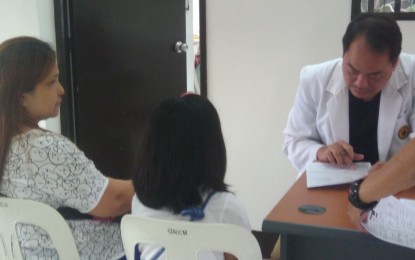
DENGVAXIA PROFILING. Sta Rosa Community Hospital Medical Director Dr. Parnell Patacsil (rightmost) checks on the Dengvaxia vaccinee's provided data at the start of the Department of Health physical examination activities held at the Sta Rosa Community Hospital on Friday. (Photo courtesy of Gladys S. Pino/PNA)
SANTA ROSA CITY, Laguna – The Regional Epidemiology and Surveillance Unit (RESU) of the Department of Health (DOH) in Region IV-A (Calabarzon) reported Friday an additional 562 ‘Adverse Event Following Dengvaxia Immunization’ (AEFDI) cases from Aug. 4 to 10 this year, bringing the total number to 17,565 cases since Dec.1 last year.
RESU, in its surveilance report, said that of the total AEFDI cases in the region, 56 vaccinees, or 0.2 percent, have died.
Majority of the reported cases, RESU said, were females, with ages ranging from 2 to 46 years old.
Laguna has the most reported AEFDI cases (5,282 or 30%), followed by Batangas (4,639 or 26%), and Cavite with 3,637 cases or 21%.
In its bid to generate evidence based information on the possible effects of the Dengvaxia vaccine and monitor the health status of its vaccinees, DOH-Calabarzon started the conduct of laboratory check and other physical examination routine to public school children who received the Dengvaxia vaccine in year 2016 to 2017 at the Sta. Rosa Community Hospital (SRCH) here on Friday.
The series of medical services (from complete blood and platelette count, X-ray, urinalysis, including height, weight and body measurement and physical examination conducted by government doctors serve as a follow-up to the ongoing profiling activity for those vaccinated with Dengvaxia in the Calabarzon provinces of Cavite, Laguna, Batangas, Rizal, and Quezon, which started last July 31.
In a statement provided by DOH-4A Community Affairs and Media Relations Officer Glen Ramos on Friday, DOH Calabarzon Director Eduardo C. Janairo said that this continuing monitoring activity is not only to provide support for Dengvaxia vaccinees in the region, but also to enable DOH to know whatever changes or any health concerns that might have been triggered by the vaccine.
The conduct of the physical exam aims to check on any possible disease, so they can be treated immediately, identify any issues that may become medical concerns in the future, as well as ensure that every vaccine is maintaining a healthy diet and routine.
“We need to have accurate medical information about the effects of the vaccine, if there are any, that can be used to generate definite health decisions based on these physical exams,” Janairo said.
SRCH Medical Director Parnell Patacsil led the pool of doctors who alternately checked on the Dengvaxia vaccine recipients, who were Grade 4 public school students when they received the vaccine in 2016 to 2017.
Carol Fortaleza, a mother of four, whose 3rd child “RV” was vaccinated three times from April of 2016 and every six months thereafter, said “nagpapasalamat kami at ginagawa nila ang kung anuman ang importante” (we are thankful that they are doing whatever is important) when asked about this DOH initiative.
Another mother, Claudia Gagarin, a housewife and mother to Dengvaxia vaccinees “Je” and “Cyriz” expressed that with this DOH program, “medyo nakakawala ng kaba, kse alam mong andyan sila nakaalalay sayo,” (drives away fears, because we know they are there to support us)
But when asked whether they will give their consent to whatever DOH vaccine programs in the future, they both expressed their reservations.
DOH Development Management Officer in IV-A Rene Fernando said the DOH is very much aware of these apprehensions but its effects on the ongoing DOH vaccine programs are still on its minimal level.
Besides, DOH Calabarzon embarked on these monitoring activities to help address confusion and avoid panic among those vaccinated and their families.
SRCH was set to conduct PE from Monday to Saturday, from 8 a.m. to 5 p.m.
Assisting doctors included SRCH Resident Doctor Irene Maroto and another doctor from Community Health Office 2, Dr. Mayrose Nocum, with nurse Helena D. Mendoza, RN from SRCH's Infection Control and Disease Supervaillance Unit.
In a masterlist provided by DOH Calabarzon, there were a total of 171,276 students who received the first dose of the vaccine in Calabarzon, where Cavite has the highest number of recipients (45,592), followed by Batangas (39,493), Quezon (29,809), Rizal (29,427) and Laguna (26,995).
Some 141,078 received the second dose and 82,815 received the final dose. (PNA)
